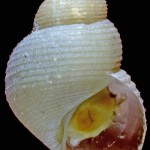You can see from yesterday’s post and comments that we are tapping into the science of fish baloney. A commenter took offense to my remarks and misspelling of surimi, a processed food product made from pollock. Pollock, hake, and cod are Gadiforms in the families Gadidae and Moridae. Together these fish feed millions of people. I apologize for any misgivings. I actually like surimi and bologna. Baloney and cheese sandwiches are my favorite snack to bring kayaking. Seriously. They stay fresh all day.
The commenter also pointed out that I need to do more research before I write about this stuff. This is undoubtedly true. I apologize again. My intention was to write about fishes. Yesterday was a meandering prologue that never quite reached the point. I wanted to say, “When you see frozen fish sticks, think cod; when you eyeball the seafood salad at Subway, think pollock.” Deep-sea fishes are all around us, but we know very little about them. For example, did you know cod have a bioluminescent anus? And they cannibalize their young? If not, please, read on.
The majority of fish species (~ 80%) occur on the continental shelf between 0-200m. Relatively few species (~ 13%) inhabit the deep-sea. Like shallow fishes, the bathypelagic and benthic fishes are most diverse in the tropics, but they can occur in abundance in productive sub-tropical waters. Some deep fishes are cosmopolitan, meaning they occur worldwide. A comparative study of 1500 deep midwater trawls netted 220 species in 46 families from 115,000 fish off Bermuda and 113 species in the East Pacific in 49 families in 56,000 fish. Nearly 90% of the fish were bristlemouths (Gonostomatidae) and lanternfish (Myctophidae). Most species were represented by 1-20 individuals. The average size was 4-6 in. (10-15 cm) (McKee pers comm , needs ref.). Midwater fishes are small. As we get closer to the bottom, the fish get bigger (like pollock and hake), because of the greater availability of food. All are carnivorous.
In fact, they eat their young. Cannibalism is a widespread phenomenon in deep sea fishes. In most fish species, cannibalism is only an occasional part of the diet. This may increase under intense culture, or when other prey is absent. In some other species, cannibalism is a major part of the diet. Conspecifics account for 40% of the diet in silver hake, 49% of the diet in walleye pollock, and more than 70% of the diet of Cape Hake. Benefits to cannibal predators include increased growth, increased fecundity, and reduced competition primarily resulting from density dependent effects. Another benefit of cannibalism is increased encounter rates with large prey sizes that might otherwise be rare (see Juanes, 2003 for complete citations).
It was explained to me like this. A large hake fish gets no nutritional benefits from eating tiny copepods because the adult expends too much energy in the pursuit. Instead, juvenile hake fish prey upon the tiny copepods. When the juveniles grow big enough to yield nutritional benefits to the adult fish, they get eaten. Evolutionary fitness is passed on to the survivors.
It’s a cruel world down there, isn’t it? You can see this kind of behavior in freshwater aquariums, too. A clown loach will devour an entire cohort of invasive snails in a hours, but let one big one live to reproduce another day. It’s like farming for the future, in a creepy Sweeny Todd meets Soilent Green kinda way. Who’d have thought deep fishes were so downright viscious? Serves ’em right, eh? Pass the fish sticks. I think I’ll have another.
That’s it for Science Week, folks. Hope you enjoyed it as much as we did.





